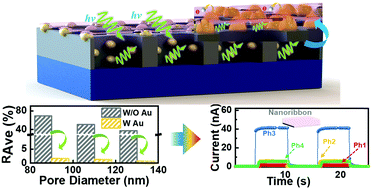Controllable 3D plasmonic nanostructures for high-quantum-efficiency UV photodetectors based on 2D and 0D materials†
Abstract
The confinement of incident light waves for light–matter interactions, especially for 2D materials with axially limited areas, commonly limits the development of high-performance photodetectors with a wide range of semiconductors in the nanoscale. Herein, we propose an approach to spatially extend the light confinement effect from 2D to 3D with Au nanostructure/anodic aluminum oxide (AAO) matrix plasmonic architectures. The incident light beams were initially concentrated by the Au nanostructures (NSs) and the strong plasmon optical interference within AAO matrixes subsequently offered an effective way to trap the light transmitted from the Au NS layers, which was recursively collected by Au NSs. The optical properties of the 3D plasmonic NSs correspondingly exhibited strong morphological dependence, which was evidenced by the tunable intensified Raman vibrational signals of the R6G molecules with a prominent enhancement factor up to 1 × 108. As a consequence, the 3D plasmonic nanostructures can be successfully applied in various dimensional materials and overcome the limited solar energy utilization for the ultra-thin 2D p-MSB nanoribbons, resulting in a high quantum efficiency up to 1068% under 0.5 mW cm−2 UV light illumination.



 Please wait while we load your content...
Please wait while we load your content...